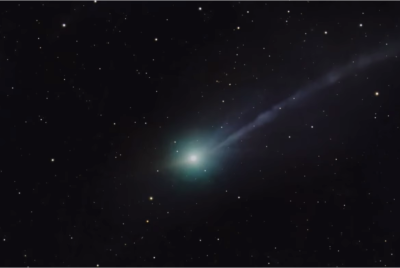3I/ATLAS: NASA Defends Its Fuzzy HiRISE Images As Amateurs Produce Sharper Views
NASA defends its results, arguing the data—though not magazine-ready—is crucial for science

NASA is defending its official, fuzzy images of Comet 3I/ATLAS captured by its powerful HiRISE camera, even as amateur astronomers are now releasing substantially sharper views of the mysterious object. This unexpected comparison has ignited a debate over who is capturing the clearest cosmic portrait of the comet.
Enthusiasts had been waiting for high-resolution pictures of the third-ever interstellar visitor, exocomet 3I/ATLAS. However, the highly anticipated NASA broadcast, which was meant to release these unseen images of the unusual object, unfortunately fell short of their expectations.
NASA's Blurred Photo: The Great Let-Down
Since the comet 3I/ATLAS was discovered on 1 July 2025 by the ATLAS observatory in Chile (the Asteroid Terrestrial-impact Last Alert System), it has caused confusion among experts and the general public.
The ATLAS system has identified many objects to date, including 1,293 Near-Earth Asteroids (NEAs), 112 potentially dangerous asteroids, 4,957 supernovas, and 110 comets. It can detect asteroids as small as 20 metres. Even with all these findings, no discovery has been more puzzling than the comet 3I/ATLAS.
Harvard astrophysicist Avi Loeb has noted 12 unusual features of the object. These puzzles include their path, their 'anti-tail' feature, a large amount of nickel present, and their potential starting place (the WOW! signal), among others.
Because of the government shutdown, the highly anticipated NASA information was postponed, so everyone had to wait.
The official images came from several NASA assets, including the HiRISE camera aboard the Mars Reconnaissance Orbiter (MRO), the MAVEN mission (Mars Atmosphere and Volatile EvolutioN), the STEREO mission, SOHO (Solar and Heliospheric Observatory), as well as the Psyche and Lucy spacecraft.
READ MORE: NASA Responds to Viral 'Alien Ship' Theory After Baba Vanga Prediction Resurfaces
READ MORE: ISRO Captures 3I/ATLAS in Unprecedented Detail — A Quiet Event With Big Impact
People online are comparing these pictures with those taken by amateur astronomers on Earth, who have captured images that are noticeably more impressive.
3I/ATLAS!
— ZWO (@zwoastro) November 21, 2025
Ben Frederick captured the Interstellar Comet 3I/ATLAS
📸 Camera: ZWO ASI533MC Pro
🔭 Telescope: Askar 71F
📍 Bortle 4/5 skies
Processing: PixInsight + RC Astro plug-ins
57 × 60s exposures @ gain 100, –14 °C#ZWO #ASI533MCPro #Astrophotography #Comet #3IATLAS pic.twitter.com/9ZDn9c1z3i
🚨BREAKING SHOCKING 3I/ATLAS:
— SpaceTracker.space (@Ammar1176708) November 21, 2025
🌠NEW COMET 3I/ATLAS IMAGES — I AM SHOCKED.
This is the most recent and clearest look at 3I/ATLAS yet — Nov 20, 2025 — and it looks NOTHING like any comet approaching Earth.
IMAGES:https://t.co/CXodsbaawG
👇 Share your comment below 📷New release… pic.twitter.com/yDvLHFN44o
Taken at 0545h UT this morning. 40x15s shots of 2025 K1 (ATLAS) pic.twitter.com/GzcYJtNsOf
— David Strange (@dgs99) November 20, 2025
Interstellar visitor 3I ATLAS. Only managed a few minutes few clouds came over. pic.twitter.com/Yr5hGek5dl
— David Strange (@dgs99) November 19, 2025
Why NASA's Pictures Look Blurry
Amid growing disapproval, NASA used social media to address public concerns and explain its reasoning. The agency pointed out that the results were to be expected, saying, 'Lots of reasons...but in short, it's not what these spacecraft were designed to do. As comet 3I/ATLAS swooped by, we jumped on the opportunity to turn our instruments its way and see what we could get.'
❓Why so blurry❓
— NASA Solar System (@NASASolarSystem) November 20, 2025
Lots of reasons…but in short, it’s not what these spacecraft were designed to do. As comet 3I/ATLAS swooped by, we jumped on the opportunity to turn our instruments its way and see what we could get. Take HiRISE as an example.👇
The left is what it was… pic.twitter.com/A5NuecHYWb
NASA then used the HiRISE picture as a specific example. The image on the left (picture 1), they explained, shows what the camera was built to photograph: the bright, near, and stable Martian surface.
❓Timing❓
— NASA Solar System (@NASASolarSystem) November 20, 2025
These were the images taken during the government shutdown. While our spacecraft were still permitted to operate, our content releases were required to be paused. Now that we’re fully operational again, we’re sharing everything they’ve observed over the past few weeks.
The picture on the right (picture 2), by contrast, is what the camera managed to capture of the faint, far-off, and quickly moving comet 3I/ATLAS. NASA acknowledged that while it may not be suitable for a 'magazine cover', the image is still extremely valuable for research.
READ MORE: 3I/ATLAS Is Alive? New Preprint Claims Object Is a Plasmatic Organism
READ MORE: NASA SkyCam Footage: 'Red Exhausts' On Triangular Object Stun Viewers
Defining 'Unsuccessful' Images
The contrast between NASA's official HiRISE images and the stunning photographs shared by amateur astronomers clearly shows two distinct goals at work. While the agency admits its results are not picture-perfect, it maintains that the faint, blurry data is still crucial for scientific study and understanding the comet's unique features.
Ultimately, this situation forces us to question what makes a celestial image truly successful: breathtaking clarity or the hidden information that only official instruments can detect. The debate over who secured the best shot of 3I/ATLAS continues.
© Copyright IBTimes 2025. All rights reserved.





















